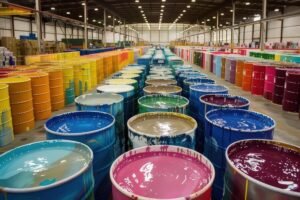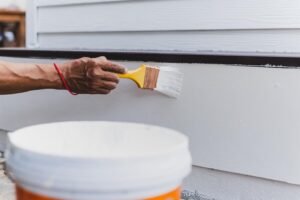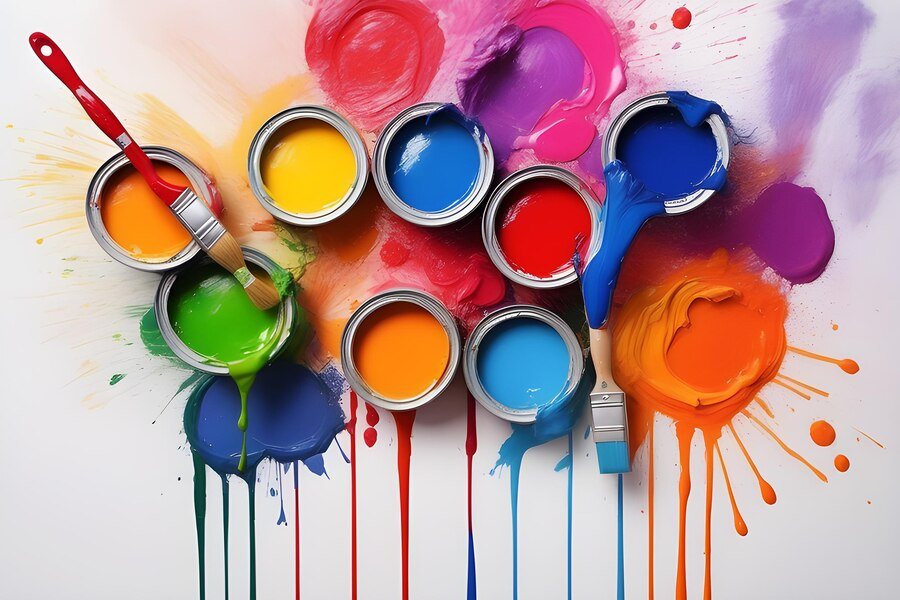Introduction to Water-Based Paints
Water-based paints are a versatile and environmentally friendly choice for a wide range of applications across both professional and DIY projects. Unlike traditional oil-based paints, water-based options utilize water as their primary solvent, which significantly reduces the presence of volatile organic compounds (VOCs) that can be harmful to both health and the environment. This key difference in composition makes water-based paints not only safer but also more convenient to use, as they can often be cleaned up with just soap and water.
The rise in popularity of water-based paints is largely attributed to their advanced formulation, which provides excellent coverage, vibrant colors, and a quick drying time. These paints can be found in a variety of types, including acrylics and latex, each offering unique properties suited to different applications. For instance, acrylic paint is known for its durability and resistance to fading, while latex paint is often favored for its ease of application and lower odor. Both types of water-based paints have become go-to options for artists, home decorators, and professional painters alike.
Furthermore, the eco-friendly nature of water-based paints resonates with a growing demographic of environmentally conscious consumers. As more individuals seek sustainable solutions for their home improvement projects, products like mithila paints have emerged as a popular alternative to conventional paints. These paint formulations not only adhere to stringent environmental standards but also offer the aesthetic appeal and functionality desired by users. In addition, their quick-drying properties enable faster project completion with minimized disruption. The evolution of water-based paints, thus, marks a significant shift in the industry towards greater sustainability and user-friendliness.

Benefits of Using Water-Based Paints
Water-based paints offer a multitude of advantages that make them an increasingly popular choice among both amateur and professional painters. One of the most significant benefits is their low toxicity. Unlike solvent-based paints, which often contain harmful volatile organic compounds (VOCs), water-based paints primarily use water as a solvent. This attribute not only makes them safer for the environment but also promotes better indoor air quality, thereby reducing health risks associated with inhaling harmful fumes.
Another notable advantage is the quick drying time that water-based paints provide. Typically, these paints dry to the touch within minutes, allowing for faster project completion and reducing the inconvenience of waiting hours or even days. This efficiency is particularly beneficial when multiple coats are necessary, as it enables quicker work without compromising the quality of the finish.
Furthermore, cleanup after using water-based paints is notably straightforward, as soap and water will suffice for removing any spills or brushes. This ease of cleaning enhances the user experience, especially for those who may not have extensive painting expertise. The reduced odor associated with water-based paints is an additional perk, making for a more pleasant working environment. This characteristic is especially advantageous for indoor projects, where strong odors can be disruptive and oppressive.
In a broader context, using water-based paints contributes to a safer and more comfortable painting environment. Their low toxicity, quick-drying nature, easy cleanup, and lower odor levels not only facilitate a more enjoyable painting experience but also make them suitable for various applications, including residential and commercial settings. Overall, water-based paints, including various brands and types available in the market, present compelling benefits for those looking to embark on their next painting project.
Types of Water-Based Paints
Water-based paints encompass a variety of formulations, each designed for specific applications and desired finishes. Among the most common types are acrylic, latex, and vinyl paints. Understanding the distinct characteristics and uses of these paint types is essential for choosing the right product for any project.
Acrylic paints are a versatile choice that dries quickly and is known for its excellent color retention and durability. These paints are suitable for both interior and exterior surfaces, making them ideal for a wide array of applications, including wall art, furniture refinishing, and even outdoor projects. Artists frequently prefer acrylics due to their capability to be used on different surfaces, including canvas and wood. Additionally, the ease with which acrylic paints can be cleaned up with water adds to their appeal.
Latex paints, which are often synonymous with water-based paints, are commonly used for interior walls and ceilings. They offer good coverage, flexibility, and a wide range of finishes from matte to glossy. One of the primary advantages of latex paints is their low levels of volatile organic compounds (VOCs), contributing to healthier indoor air quality. This type of paint is also relatively easy to apply and repaints well, making it an excellent choice for residential spaces.
Vinyl paints, while less common than the other types, feature a unique formulation designed primarily for surfaces that require a great deal of flexibility and moisture resistance. Often used in spaces like bathrooms and kitchens, vinyl paints excel in high-humidity environments. They work well on surfaces that experience frequent cleaning or need to withstand humidity, making them a reliable option in these areas.
In conclusion, selecting the appropriate type of water-based paint is essential for ensuring the success of your project. Whether opting for acrylic, latex, or vinyl paints, understanding their specific uses and properties will enable you to make an informed decision tailored to your needs.

Choosing the Right Water-Based Paint for Your Project
Selecting the appropriate water-based paint for any project requires careful consideration of various factors, including the surface type, desired finish, and color preferences. Water-based paints, such as mithila paints, have gained popularity for their versatility, ease of use, and environmental benefits. However, understanding the specific requirements of your project will ensure you achieve the best results.
The first step in choosing the right water-based paint is to assess the surface on which it will be applied. Different surfaces, such as wood, drywall, or metal, may require specific formulations that promote better adhesion and durability. For instance, mithila paints designed for wood surfaces typically contain additives that enhance moisture resistance, while those intended for metal may include rust inhibitors. Always consult manufacturer’s guidelines to match the paint type with the surface for optimal performance.
Next, consider the desired finish of your project. Water-based paints are available in a variety of finishes, including matte, satin, semi-gloss, and gloss. Each finish not only affects the aesthetic appeal but also influences the paint’s durability and maintenance requirements. A glossy finish, for example, is more resistant to stains and easier to clean, making it ideal for high-traffic areas. In contrast, a matte finish may be preferable for walls in low-traffic spaces where a soft look is desired. Choose a finish that aligns with both functional needs and personal style.
Lastly, color preferences play a crucial role in your selection process. Mithila paints offer a wide range of colors that evoke various moods and styles. When selecting a color, consider the overall design theme of your space and how the chosen hue interacts with natural and artificial lighting. Testing small samples on the surface can help you visualize the final outcome, ensuring that your choice complements the ambiance you wish to create.

Preparation and Application Techniques
When utilizing water-based paints, proper preparation is crucial to ensuring the best possible outcome. The first step in this process is to clean the surface that will be painted. Any dirt, dust, or grease can compromise the adhesion of the paint, leading to an uneven finish or premature peeling. For most surfaces, a mixture of warm water and mild detergent is sufficient. After cleaning, allow the area to dry completely before proceeding.
Priming is another essential step in the preparation phase, particularly when painting porous surfaces or when transitioning from a darker to a lighter color. A quality primer acts as a sealant, curbing absorption and providing a uniform base. It is advisable to select a primer that is compatible with water-based coatings. For instance, if you are working with mithila paints, consider using a water-based primer designed for acrylic or latex paints to ensure compatibility and performance.
Choosing the right tools significantly influences the application process. High-quality brushes and rollers tailored for use with water-based paints will provide the best results. Look for synthetic brushes, as they are designed to work well with water-based formulations. Additionally, avoid using excessive amounts of paint on the brush or roller to reduce the risk of drips and uneven distribution.
During application, employ techniques that promote a smooth finish. For larger surfaces, use a roller for even distribution, followed by a brush to detail edges and corners. Moreover, it is advisable to apply multiple thin coats rather than one thick layer. This method enhances coverage while minimizing the risk of runs and drips. If you encounter bubbles during the application process, gently roll over them with a dry roller or brush to alleviate the issue. Ultimately, effective preparation and the right application techniques ensure a successful water-based painting project.
Drying Time and Curing Process
The drying time associated with water-based paints, such as mithila paints, is a key consideration for homeowners and professional painters alike. Typically, these paints dry to the touch within one to two hours, depending on factors such as the formulation, application thickness, and environmental conditions. However, it is essential to note that while the surface may feel dry, the paint may still require additional time to cure fully. The curing process, which can last anywhere from a few days to several weeks, involves the complete hardening and bonding of the paint to the substrate.
Environmental conditions significantly influence both drying times and curing processes. Higher humidity levels can prolong drying times, as moisture present in the air affects how quickly the water in these paints evaporates. Conversely, low humidity can expedite the drying process, but could also lead to issues like cracking if the paint dries too quickly. Temperature plays a crucial role as well; optimal drying occurs at temperatures between 50°F and 85°F (10°C to 29°C). Under colder conditions, expect slower drying and curing times, which can disrupt project timelines if multiple coats are necessary.
As homeowners embark on renovation or decorating projects using water-based products like mithila paints, understanding the implications of drying times is essential. Ensuring adequate time between coats is vital to achieving the desired finish, as applying a second coat prematurely can lead to problems such as uneven textures or adhesion failures. Hence, it is advisable to always refer to the manufacturer’s recommendations regarding recoating times. Awareness of these factors can lead to a smoother painting experience and a more durable and aesthetically pleasing result.
Maintenance and Care for Water-Based Painted Surfaces
Maintaining and caring for surfaces painted with water-based paints is crucial to preserving their appearance and longevity. Whether you have utilized mithila paints or other varieties of water-based options, the upkeep process remains fairly consistent across different types. The first step in caring for these surfaces involves regular cleaning, which helps remove dirt, dust, and grime that can accumulate over time.
For day-to-day cleaning, a mild detergent mixed with water is often sufficient. A soft cloth or sponge should be used to gently wipe down the painted surface. It is important to avoid abrasive scrubbers, as they can damage the paint’s finish. For tougher stains or marks, a mixture of baking soda and water can be effective, offering a gentle but efficient cleaning solution without compromising the mithila paints’ vibrancy.
In the case that you notice minor imperfections or wear on the painted surface, touch-up techniques can be employed. First, ensure that the area is clean and dry. Using a small brush, apply a thin coat of the original water-based paint carefully. This method can restore the surface to its original condition without the need for extensive repainting. If the area of damage is significant, it may be necessary to repaint that section entirely to maintain a uniform appearance.
Repainting is typically recommended every three to five years, though this can vary based on environmental factors and the paint’s exposure to sunlight and moisture. When preparing to repaint, it is essential to thoroughly clean the surface and lightly sand it to promote better adhesion of the new layer of paint. By following these maintenance and care practices, surfaces painted with water-based paints can retain their vibrancy and remain intact over the years.

Common Issues and Solutions
Water-based paints, including widely-used options such as mithila paints, provide numerous benefits, but users may also encounter certain issues that affect the overall outcome of their projects. Understanding these common problems, their causes, and possible solutions can help ensure a successful application and lasting results. One prevalent issue faced by users is peeling. This often occurs when the surface was not properly prepared before painting. To resolve this, ensure that the surface is cleaned, sanded, and primed appropriately, allowing better adhesion of the paint.
Another issue is blistering, which typically arises from excessive moisture trapped underneath the paint layer. To address this, it is crucial to allow surfaces to dry completely before applying water-based paints. Additionally, ensure adequate ventilation during and after the painting process to minimize humidity levels that may contribute to blistering. In situations where blistering has already occurred, it may be necessary to remove the affected paint, allow the surface to dry, and repaint.
Color fading can also be a concern with water-based paints, including mithila paints, particularly when exposed to direct sunlight. To combat this, consider using paints with UV protection or applying a topcoat designed to enhance durability and reduce fading. Another preventative measure is the application of paint in shaded or less sun-exposed areas, when possible.
By addressing these common issues with appropriate solutions, users can maximize the performance of water-based paints, ensuring their projects maintain a vibrant appearance over time. Regular maintenance and timely touch-ups can further enhance the longevity, preserving the aesthetic and functional qualities associated with mithila paints and similar water-based products.
The Environmental Impact of Water-Based Paints
Water-based paints have garnered attention not only for their versatile applications but also for their positive environmental implications. One significant advantage of these paints is their formulation, which emphasizes low toxicity and eco-friendliness. Traditional solvent-based paints often contain harmful chemicals that contribute to air pollution and can adversely affect indoor air quality. In contrast, water-based options typically utilize water as the primary solvent, significantly reducing the emission of volatile organic compounds (VOCs). This reduction in VOCs is crucial as these compounds can lead to various health issues, from headaches to long-term respiratory problems.
Moreover, manufacturers of water-based paints, such as those producing Mithila paints, are increasingly focusing on sustainable practices. Many brands are now committed to using environmentally safe pigments and materials that minimize harm to ecosystems. These practices not only enhance the safety of water-based paints for consumers but also lessen their impact on the environment when they are disposed of after use. For example, opting for a paint with eco-friendly certifications ensures that harmful substances are either reduced or absent altogether, making it a preferable choice for conscientious consumers.
Consumers can further amplify their environmental impact by making informed choices regarding these products. Researching brands that prioritize sustainability, looking for eco-labels, and considering the environmental policies of the manufacturers can guide users toward more responsible decorating decisions. By choosing water-based paints, particularly those like Mithila paints that emphasize natural ingredients and reduced toxicity, consumers contribute to a healthier planet and promote a greener future. This choice aligns with growing global efforts to adopt sustainable practices in daily life and industry, paving the way for an eco-conscious society.

